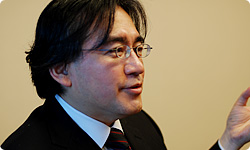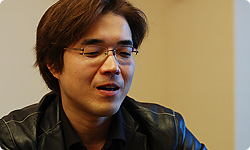3. A Warriors Game on Two Screens
Samurai Warriors exists because Dynasty Warriors 2 existed, but you didn’t just switch in new characters.
No. If we had made the same thing, just switching the theme, it wouldn’t have been that interesting. So for Samurai Warriors, we thought about focusing on each character and establishing their personalities. In Dynasty Warriors 2, you fight on a wide-open field, but castles are more representative of the Sengoku (Warring States) period, so in Samurai Warriors, we decided to feature castles and the characters surrounding them in order to create a difference.
How exactly do you establish the personalities of the characters?
When we make a Samurai Warriors game, we determine a broad course - which story from which time period we want to portray - and then research the anecdotes surrounding the various historical figures.
You thoroughly research the historical accounts.
Right. When we decide on certain warlords to feature and build up a story, weak points always appear. We complement that with some fiction to further establish the characters, but the basis is always historical.
You don’t change history for your own convenience.
No, we never do that. We only arrange it so it becomes more interesting as a game.
I see. Are all of the staff members knowledgeable about the Three Kingdoms and the Sengoku period? Or is there a mix of experts and mere dabblers?
It’s a mix. Some are like walking dictionaries. They go visit castles in their free time! (laughs)
I thought so. (laughs)
And someone has actually been to see the Red Cliffs, scene of the biggest battle17 in the Three Kingdoms period. 17 The biggest battle in the Three Kingdoms period: The Battle of Red Cliffs. A battle between the armies of Cao Cao and the combined forces of Liu Bei and Sun Quan at the Red Cliffs by the Yangtze River in the year 208 A.D. during the end of the late Han Dynasty in China.
So some of you actually go all the way to the Yangtze River?
Yes. But we also have people who have a passing interest in history and others with no interest at all.
If only experts were making the game, it would become unbalanced, so it’s healthy to have all sorts of people.
Yes. When we play-tested it in-house, there were lots of opinions, which was very interesting. Sometimes there would be completely opposite opinions and I’d think, “Which one should I believe?” (laughs)
You always hear that the winners write history. Even within the historical evidence, there are opposite accounts with regard to the same person depending on interpretation and where it’s presented.

Yes. I do think that history is written by winners. For example, a lot of unflattering things are written about Mitsuhide Akechi, who instigated the Incident at Honnoji, but that’s because Hideyoshi Toyotomi later defeated him. I think, however, that Mitsuhide must have had his reasons. So in the games we have tried to portray him flatteringly, to create history as he may have seen it.
I see. Did you always like the history of the Sengoku period?
I wasn’t that knowledgeable, but I had encountered it through video games.
You learned about the Three Kingdoms in your high school club room and about Nobunaga at the snack shop. (laughs)
Yeah. (laughs) I read novels about the Sengoku period by Ryotaro Shiba18 and the historical manga series Sangokushi by Mitsuteru Yokoyama.19 18 Ryotaro Shiba: An author who wrote many historical novels, such as Ryoma ga Yuku and Saka no Ue no Kumo. He passed away in 1996. 19 Mitsuteru Yokoyama: A manga author whose works, such as Tetsujin 28-go, Sally the Witch and Sangokushi, cover a wide variety of genres. He passed away in 2004.
That’s an interesting series. (laughs)
Yeah. (laughs) Sixty volumes of Sangokushi, as well as Suikoden, are still at my parent’s house. I was buying and reading all of those, so you might say I was enjoying the stories rather than studying the history.
Now what was your first impression when you saw the Nintendo 3DS system?
I was shocked the first time I saw it. There were about 100 people in the room, and I was the first one to see the Nintendo 3DS system brought by Nintendo, but I was so surprised that I couldn’t help but shout out “Whoa!”
It just burst out. (laughs)
Yeah. And I’m not the type to do that when I’m surprised.
You’ve seen a lot of new hardware and got used to so many things that not just anything will surprise you.
Yeah. What I saw at that time was Animal Crossing.20 I was shocked, and I thought, “So that… looks like this…” 20 Animal Crossing (tentative title): A new game in the Animal Crossing series that is currently under development for the Nintendo 3DS system. Release date: TBD.

Did the staff members from Nintendo just show you the system and say, “Take a look at this,” without telling you that it was glasses-free 3D?
Yes. They didn’t even explain that it was Animal Crossing.
I see… So that’s how they presented it! (laughs)
I was absolutely floored. (laughs)
When you first tried out the new hardware, how did you think you would develop the Warriors series for the Nintendo 3DS system?
The Warriors series goes back ten years, and Samurai Warriors for seven. As the series has built up, it’s gotten harder to add new elements.
That has a tendency to happen when ten years have passed since the first product in a series.
Yes. But with the Nintendo 3DS system, the visuals are 3D - with a sense of depth - so of course I wanted to make full use of that.
Showing stunning graphics in 3D was a given.
Yes. And something that’s completely new for the series - although some might say it’s so obvious - is that there are two screens.
This is actually the first time for a Warriors game to use two screens, one of which is a Touch Screen.
Yes. I thought I would construct new game mechanics around that. I adopted a system whereby you can swap in a number of warlords, up to four at a time. You fight on the upper screen, while on the lower screen you issue commands and observe the overall situation. You can instantly switch among the four warlords in their respective places.
The Warriors games have always been busy, but now there’s more to do all at once.
Yes. It’s pretty frantic this time. But in a good way. The Warriors games have always involved long travel time. They’re fun when you’re fighting on the battlefield, but there’s little play on your way to the next place.
You mean that you travel, fight like crazy, travel, fight like crazy, over and over again, and the travel times drag on a bit?
Yes. This time, battlefields show up as you’re travelling, and when that happens, you can swap in other warlords. That way you can always enjoy that feeling of one against many.
It maintains that feeling, so gameplay feels more tightly concentrated.
Right. Until now in the Warriors series, the lengthy travel time was a challenge, a wall we never quite overcame, but this time I think we did it.